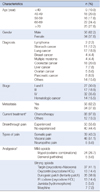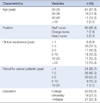Abstract
Purpose
This study was conducted to compare the levels of pain intensity and pain relief between cancer patients and nursing records, and to compare the barriers to pain control between cancer patients and their nurses.
Methods
Data were collected from 90 cancer patients who were admitted to three oncology wards and 90 oncology nurses in the same three wards at C University Hospital in G City from July to September, 2012.
Results
The most severe pain intensity reported by cancer patients was 6.59 points on the first day of analgesic treatment, while that of their nursing records was 3.98 points on the first day. There were significant changes in pain intensity over time between two groups (F=142.07, p<.001). The highest level of pain relief reported by patients was 2.87 points on the third day, while that of nursing records was 1.67 points on the first day. The score for the social system area of barriers to pain control among the nurses was higher than that of cancer patients (t=-3.69, p=.021).
Figures and Tables
References
1. Ahles TA, Blanchard EB, Ruckdeschel JC. The multidimensional nature of cancer-related pain. Pain. 1983; 17(3):277–288.

2. Yang SA, Cho OH, Yoo YS. A survey of cancer patients who visited emergency room. Korean J Hosp Palliat Care. 2009; 12(4):228–233.

4. Kim HT, Koh JW, Kim YM, Kang MS, Noh HS, Kim HR, et al. Pain management based on NCCN guideline in patient with lung cancer. Tuberc Respir Dis. 2009; 67(3):221–225.

5. National Cancer Information Center. Cancer pain management guideline. 5th ed. Seoul: National Cancer Information Center;2012.
6. Korea Health Industry Development Institute. Guideline for hospital evaluation programme. Seoul: Ministry Health and Welfare Press;2007.
7. Kim HS, Yu SJ, Kwon SY, Park YH. Differences in patients' and family caregivers' ratings of cancer pain. Korean J Hosp Palliat Care. 2008; 11(2):42–50.
8. Kim YJ. Actual condition of pain and pain control and satisfaction of pain control in hospitalized cancer patients [dissertation]. Daegu: Kosin Univ.;2007.
9. Moon YM, Ham OK, Kim JH, Lim JY. Degree of pain, and barriers and satisfaction with pain management among home care cancer patients. J Korean Acad Public Health Nurs. 2008; 22:177–185.
10. Sin SB, Lee MH. The effect of cancer pain management education on the pain and the concerns of pain management in cancer patients. Korean J Rehabil Nurs. 2003; 6(1):90–103.
11. Kim HJ, Park IS, Kang KJ. Knowledge and awareness of nurses and doctors regarding cancer pain management in a tertiary hospital. Asian Oncol Nurs. 2012; 12(2):147–155.

12. Jo EK. Nurses' knowledge and performance of cancer pain management [dissertation]. Daegu: Keimyung Univ.;2010.
13. Agency for Health Care Policy and Research. Barriers to effective pain management. Accessed July 1, 2012. http://www.ahcpr.gov.
14. Korea Institute for Healthcare Accreditation. Accreditation standard for healthcare institute. Seoul: Korea Institute for Healthcare Accreditation;2010.
15. McCaffery M, Ferrell BR. Nurses' knowledge about cancer pain: a survey of five countries. J Pain Symptom Manage. 1995; 10(5):356–369.

16. McCaffrey M, Beebe A. Managing your patients' adverse reactions to narcotics. Nursing. 1989; 19(10):166–168.
17. McCaffery M. Pain control : Barriers to the use of available information. World health organization expert committee on cancer pain relief and active supportive care. Cancer. 1992; 70:5 Suppl. 1438–1449.
18. Gunnarsdottir S, Donovan HS, Voge C, Ward S. Patient-related barriers to pain management: the barriers questionnaire II (BQ-II). Pain. 2002; 99(3):385–396.

19. Park IS, Jang M, Rew SA, Kim HJ, Oh PJ, Jung HJ. Analysis of pain records using electronic nursing records of hospitalized patients in medical units at a university hospital. J Korean Clin Nurs Res. 2010; 16(3):123–132.
20. Kim HK, Lee HS, Hwang KH, Yoo YS, Lee SM. Positive and negative determinants for pain management in both cancer patients and their nurses. J Korean acad Fundam Nurs. 2006; 13(1):68–75.
21. Won YH, Kim YH, Park JY. Comparison of pain management between before and after the application of guidelines in cancer emergency room. Asian Oncol Nurs. 2012; 12(3):230–236.

22. Yoo YS, Lee WH, Cho OH, Lee SW. Levels of barriers to pain management of cancer patients and their nurses. Korean J Hosp Palliat Care. 2005; 8(2):224–233.




 PDF
PDF ePub
ePub Citation
Citation Print
Print







 XML Download
XML Download